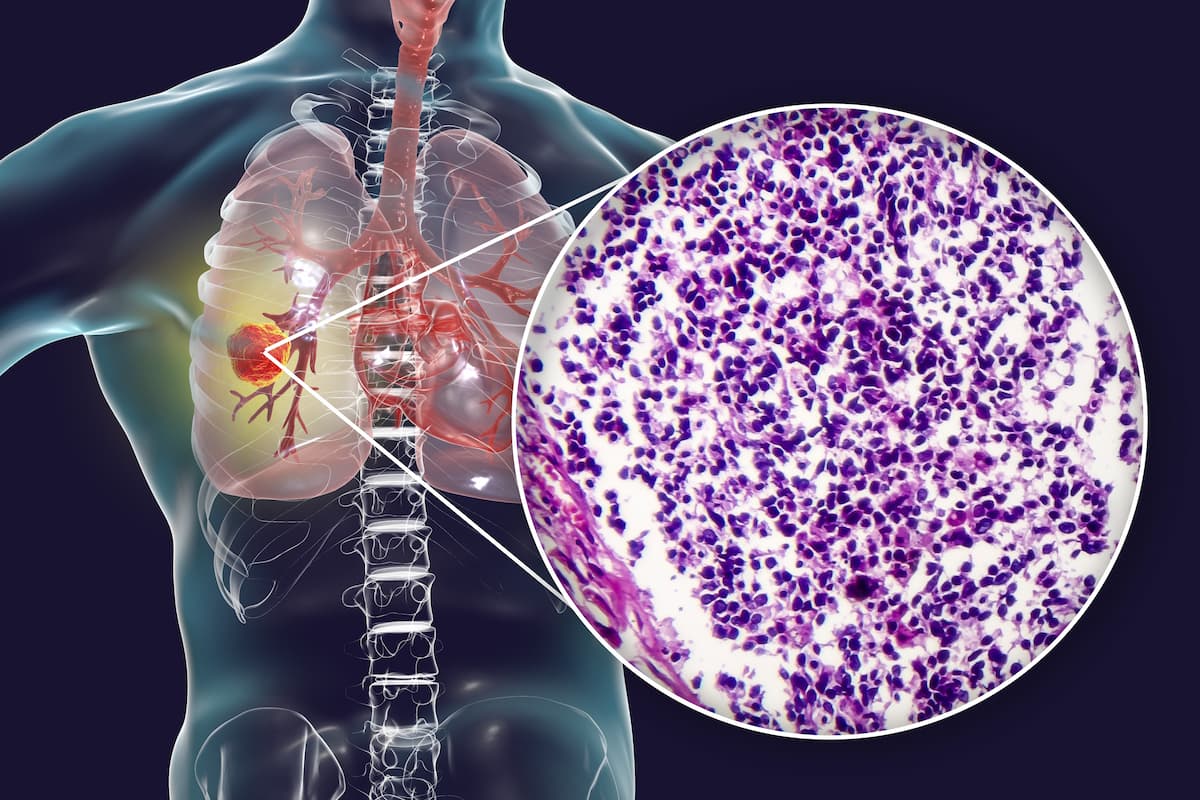Radiation Combo Elicits Efficacy in Advanced NSCLC With Brain Metastases
Radiotherapy plus camrelizumab and platinum-doublet chemotherapy showed manageable toxicity in untreated non–small cell lung cancer with brain metastases.
Radiotherapy plus camrelizumab and platinum-doublet chemotherapy showed manageable toxicity in untreated non–small cell lung cancer with brain metastases.

Brain radiotherapy in combination with camrelizumab (Airuika) and platinum-doublet chemotherapy elicited favorable efficacy in patients with previously untreated advanced non–small cell lung cancer (NSCLC) harboring no actionable driver mutations with newly diagnoses brain metastases, according to findings from the phase 2 C-Brain trial (NCT04291092) published in Lancet Oncology.1
Data from the trial showed that among all patients evaluable for efficacy (n = 65), the systemic objective response rate (ORR) was 69.2% (95% CI, 56.6%-80.1%), with 45 (69%) partial responders, 16 (25%) patients with stable disease, and 4 (6%) of patients with stable disease. The intracranial ORR among this population was 78.5% (95% CI, 66.5%-87.7%), with 18 (28%) complete responders and 33 (51%) partial responders; 13 (20%) patients had stable disease, and 1 (2%) patient had progressive disease. The disease control rate (DCR) for intracranial response and systemic response was 98.5% (95% CI, 91.7%-100.0%) and 93.8% (95% Ci, 85.0%-98.3%), respectively.
Furthermore, the median progression-free survival (PFS) in this patient population was 10.7 months (95% CI, 7.5-15.7), with 6-, 12-, and 24-month PFS rates of 71.7%, 44.2%, and 26.8%, respectively. For this patient group, the median intracranial PFS was 16.1 months (95% CI, 13.0-not reached [NR]), with respective 6-, 12-, and 24-month PFS rates of 83.0%, 65.6%, and 44.7%. Additionally, the median overall survival (OS) among patients treated with the radiotherapy combination was 20.9 months (95% CI, 13.8-27.7), and the 12- and 24-month OS rates were 70.3% and 38.4%, respectively.
“[T]he combination of brain radiotherapy with camrelizumab and platinum-doublet chemotherapy shows promising intracranial and systemic efficacy and manageable toxicity, [holding] potential as a novel option for patients with untreated NSCLC and brain metastases,” Yanjun Xu, MD, of the Department of Medical Thoracic Oncology at Zhejiang Cancer Hospital, wrote in the publication with study coinvestigators.1 “[Randomized] controlled trials are warranted to validate our findings.”
The single-arm phase 2 trial enrolled patients 18 years or older with newly radiographically diagnosed brain metastases from histologically confirmed NSCLC amenable to brain radiotherapy. Study treatment consisted of either stereotactic radiosurgery (SRS) in patients with 1 to 4 brain metastases or whole-brain radiotherapy (WBRT) for patients with more than 4 brain metastases. SRS was given in 9 to 22 Gy per fraction for up to 3 fractions, with a total dose of 22 to 27 Gy based on the volume and location of tumors. WBRT was given for a total dose of 30 Gy, delivered in 3 Gy per fraction 5 days per week.
Treatment with camrelizumab began within a week of starting radiotherapy and was given at 200 mg over 30 to 60 min every 3 weeks. Investigator’s choice of platinum-doublet chemotherapy was given and consisted of 500 mg/m2 of pemetrexed plus either carboplatin area under the curve (AUC) 5 or 75 mg/m2 of cis-platinum in non-squamous NSCLC. For squamous NSCLC, it was 260 mg/m2 of nab-paclitaxel plus either carboplatin AUC 5 or 75 mg/m2 of cis-platinum.
Chemotherapy started from the first camrelizumab cycle in those undergoing SRS and from the first or second camrelizumab cycle in those undergoing WBRT. Patients with controlled disease following 4 to 6 camrelizumab cycles entered maintenance therapy with either 200 mgofcamrelizumab alone in squamous NSCLC or with 500 mg/m2 ofpemetrexed in nonsquamous NSCLC every 3 weeks. Treatment continued until disease progression, intolerable toxicity, or after 24 months or 35 cycles of treatment.
The primary end point of the study was 6-month PFS.2 Secondary end points included PFS, intracranial PFS, systemic ORR, intracranial ORR, systemic DCR, OS, and safety.
A total of 95% of patients had treatment-related adverse events (TRAEs), with 55% experiencing grade 3 or 4 TRAEs. The most common grade 3 or 4 TRAEs were neutrophil count decreases (22%), white blood cell count decreases (15%), platelet count decreases (15%), and lymphocyte count decreases (14%). At least 1 serious TRAE was observed in 8% of patients, all of whom recovered after treatment interruption, discontinuation, or supportive care. No grade 5 TRAEs were reported.
References
- Xu Y, Chen K, Xu Y, et al. Brain radiotherapy combined with camrelizumab and platinum-doublet chemotherapy for previously untreated advanced non-small-cell lung cancer with brain metastases (C-Brain): a multicentre, single-arm, phase 2 trial. Lancet Oncol. 2025;26(1):74-84. doi:10.1016/S1470-2045(24)00643-0
- Camrelizumab combined with local treatment in NSCLC patients with BM. ClinicalTrials.gov. Updated September 10, 2021. Accessed January 29, 2025. https://tinyurl.com/yx4mddvb
Newsletter
Stay up to date on recent advances in the multidisciplinary approach to cancer.
Elevating the Quality of Cancer Care via Cross-Department Collaboration
Experts from Sibley Memorial Hospital discuss how multidisciplinary work has enhanced outcomes such as survival and resource use at their institution.